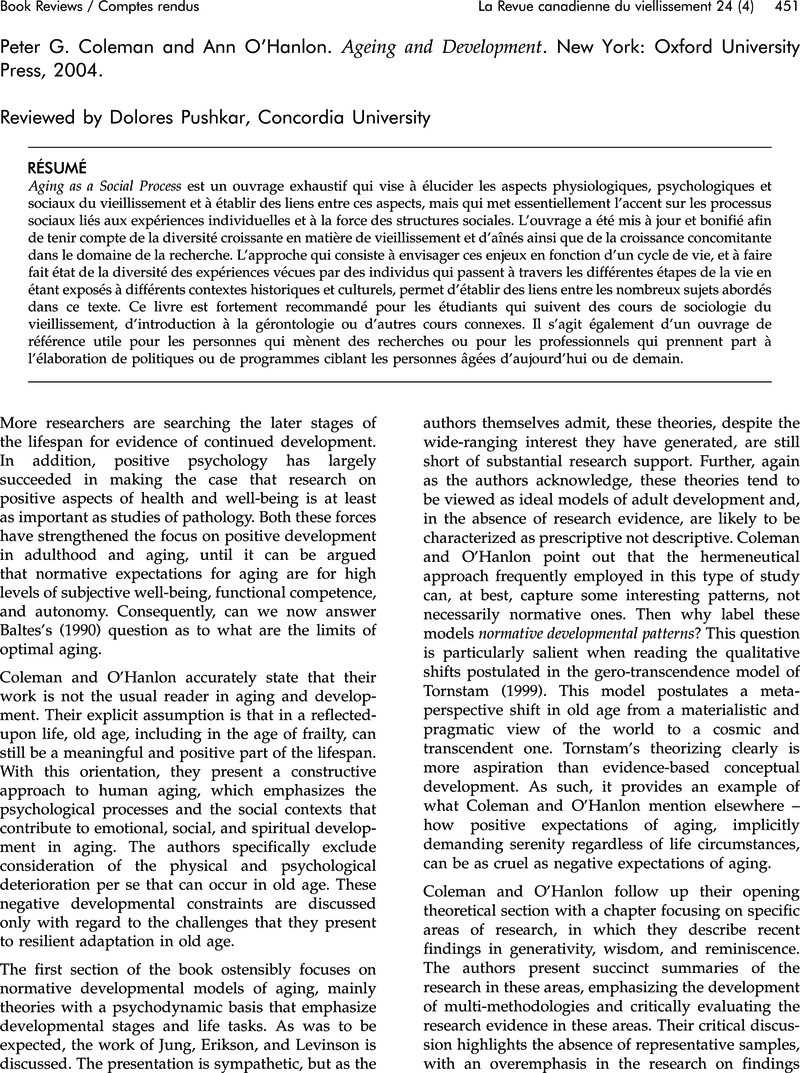No CrossRef data available.
Article contents
Peter G. Coleman and Ann O'Hanlon. Ageing and Development. New York: Oxford University Press, 2004.
Published online by Cambridge University Press: 31 March 2010
Abstract
An abstract is not available for this content so a preview has been provided. Please use the Get access link above for information on how to access this content.

- Type
- Book Reviews/Comptes rendus
- Information
- Canadian Journal on Aging / La Revue canadienne du vieillissement , Volume 24 , Issue 4 , Winter/Hiver 2005 , pp. 451 - 453
- Copyright
- Copyright © Canadian Association on Gerontology 2005
References
Argyle, M. (1999). Causes and correlates of happiness. In Kahneman, D., Diener, E., & Schwarz, N. (Eds.), Well-being: The foundations of hedonic psychology. New York: Russell Sage Foundation.Google Scholar
Baltes, P.B. (1990). A psychological model of successful aging. Canadian Association on Gerontology Annual Education and Scientific Meeting, Keynote Speaker Video Presentation, Victoria, BC.Google Scholar
Beach, S., Schulz, R., Williamson, G.M., Miller, L.S., Weiner, M.F., & Lance, C.E. (2005). Risk factors for potentially harmful informal caregiver behavior. Journal of the American Geriatrics Society, 53, 255–261.CrossRefGoogle ScholarPubMed
Brandtstädter, J., Rothermund, K., & Schmitz, U. (1998). Maintaining self-integrity and efficacy through adulthood and later life: The adaptive functions of assimilative persistence and accommodative flexibility. In Heckhausen, J. & Dweck, C.S. (Eds.), Motivation and self-regulation across the life-span (pp. 365–421). Cambridge, UK: Cambridge University Press.CrossRefGoogle Scholar
Carstensen, L.L., Isaaciwitz, D.M., & Charles, S.T. (1999). Taking time seriously: A theory of socioemotional selectivity. American Psychologist, 54, 165–181.Google Scholar
Crittenden, P.M. (2000). A dynamic-maturational approach to continuity and change in pattern of attachment. In Crittenden, P.M. & Claussen, A.H. (Eds.), The organization of attachment relationships: Maturation, culture and context (pp. 343–357). Cambridge, UK: Cambridge University Press.Google Scholar
Heckhausen, J., & Dweck, C.S. (Eds.). (1998). Motivation and self-regulation across the life-span. Cambridge, UK: Cambridge University Press.Google Scholar
Rowe, R.L. (2002). Successful aging and well-being compared with Rowe and Kahn [Guest Editorial]. Gerontologist, 42, 725–726.Google Scholar
Thomae, H. (Ed.). (1976). Patterns of aging: Findings from the Bonn Longitudinal Study of Aging. Basel, Switzerland: Karger.Google Scholar
Tornstam, L. (1999). Later-life transcendence: A new developmental perspective on aging. In Thomas, L.E. & Esienhandler, S.A., (Eds.), Religion, belief and spirituality in late life (pp. 178–201). New York: Springer.Google Scholar


